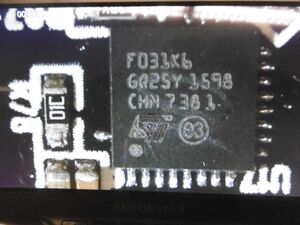Understanding the SDS011 particle sensor: Difference between revisions
No edit summary |
(Log: Understanding the SDS011 particle sensor) |
||
| Line 8: | Line 8: | ||
This article is a log of our findings while opening up the sensor and also a description of the process of understand the physics behind the functioning of the device. | This article is a log of our findings while opening up the sensor and also a description of the process of understand the physics behind the functioning of the device. | ||
== Operation of the SDS011 == | |||
In the SDS011 particles are detected by recording the light that is scattered by the dust particle when hit by a laser beam. The scatter patterns are picked up by a photo-diode which signal is amplified and then fed to a micro-controller. The micro-controller interprets the data stream and relates it to known properties of representative dust samples. How the algorithm looks like that is behind the this fitting is unknown. | In the SDS011 particles are detected by recording the light that is scattered by the dust particle when hit by a laser beam. The scatter patterns are picked up by a photo-diode which signal is amplified and then fed to a micro-controller. The micro-controller interprets the data stream and relates it to known properties of representative dust samples. How the algorithm looks like that is behind the this fitting is unknown. | ||
== Closed Firmware == | |||
Recently a number of scientific articles appeared that try to assess the validity of the SDS011 sensor. | Recently a number of scientific articles appeared that try to assess the validity of the SDS011 sensor. | ||
However, little is published about the exact physical inner workings of the device, nor on its pre-programmed firmware. Until now researchers take the functioning of the device as a black box, its firmware is considered corperate property and therefore cannot be tinkered with. | However, little is published about the exact physical inner workings of the device, nor on its pre-programmed firmware. Until now researchers take the functioning of the device as a black box, its firmware is considered corperate property and therefore cannot be tinkered with. | ||
Revision as of 08:53, 7 March 2020
Particle sensor SDS011, understanding its inner workings
On 3 March Cmpxchg and Oberoid placed the infamous SDS011 particle sensor on the dissection table at Revspace. The SDS011 is extensively used for citizen science projects when air quality is in doubt.
Our goal is to create a new algorithm for its micro-controller which can be published in the public domain and is therefore open for the scrutiny of others. This article is a log of our findings while opening up the sensor and also a description of the process of understand the physics behind the functioning of the device.
Operation of the SDS011
In the SDS011 particles are detected by recording the light that is scattered by the dust particle when hit by a laser beam. The scatter patterns are picked up by a photo-diode which signal is amplified and then fed to a micro-controller. The micro-controller interprets the data stream and relates it to known properties of representative dust samples. How the algorithm looks like that is behind the this fitting is unknown.
Closed Firmware
Recently a number of scientific articles appeared that try to assess the validity of the SDS011 sensor. However, little is published about the exact physical inner workings of the device, nor on its pre-programmed firmware. Until now researchers take the functioning of the device as a black box, its firmware is considered corperate property and therefore cannot be tinkered with.
The SDS011 is also the preferred sensor in most citizen science campaigns of governmental initiatives in Germany, The Netherlands and Belgium. For example in the monitoring campaign “de Schone Luchten”, the SDS011 plays a central role in gathering date for the public dialogue about dust exhaust of a local steel mill. Within the scientific community as in the groups of concerning citizens there is a growing concern about the the scientific significance of the data collected by the SDS011.
To estimate the scientific value of the data gathered by de SDS011, we think that it is important that the working of the device should be open to the public. Therefore we decided to open up the apparatus and investigate its inner workings.
The goal of this project is to not to crack the corporate code of the SDS011, but instead to reprogram its micro-controller with a new algorithm that is that can be the basis for the development of particle sensors in the public domain.
Most work is done at the Revspace laboratories, Netherlands. You can find us gazing over the remnants of the SDS011’s during social Tuesdays, after the bbq.
